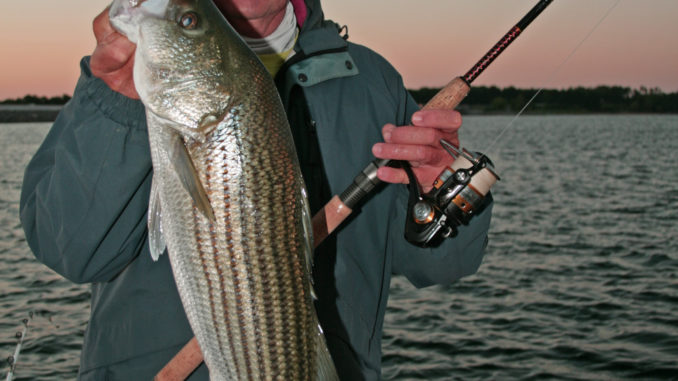
Combination of freelines, downlines, planer boards and topwaters producing stripers
The striped bass are in a migration mode at Lake Murray, and the fishing from Dreher Inland up has been excellent. According to guide Buddy Bouknight, the fishing should stay good and possibly improve over the next few weeks.
“December is a great time to catch stripers in the upper end of the lake, and one of the great things is that there are multiple ways to get bites,” said Bouknight, 62, who has been guiding full-time for 10 years. “Right now, I’m using a combination of freelines behind the boat, fishing with planer boards off to the sides as well as using down rods. In essence, I am trying to cover as much of the water column as possible with bait.
“I’ve learned when the weather gets cool and December rolls around, the stripers get on an aggressive pattern that lasts several weeks where they are caught just about every way I know how to fish for them,” said Bouknight (803-319-8722), from West Columbia. “Live blueback herring as well as gizzard shad about 6 inches long are my primary baits right now. In addition, the topwater schooling action is also occurring, and that likely will get better; I like to have a topwater lure like a Sebile trailing ice flies or bucktails to cast into the schooling fish. These are what I call opportunity fish, and I love to get into a good school of topwater feeding stripers at this time of year, but I don’t solely rely on that for my success.”
Bouknight said almost every tactic is working and most likely will continue for the next few weeks.
“I do have a specific pattern of how I use different rods when I get into an area where I mark baitfish and stripers on the graph where the bottom is often in the 20- to 30-foot depth range,” he said. “We’re catching a good number of stripers fishing free-lined bait behind the boat, but sometimes I’ll put a little weight on them, a small split-shot, to get them at different depths. The down rods with an ounce or more of weight will range from being at about 20 feet deep in the back of the boat, 15 feet deep in the middle of the boat and about 10 feet deep in the front. The planer boards will have different length of leaders with the short leaders in water as shallow as 8 to 12 feet of water if they are near the shoreline. The planer closest to the shoreline will have the shortest leader and so it won’t be as deep.
“Essentially, using these three methods, I am covering a wide swath of water at many depths. When I lock onto a productive pattern, I’ll focus on that until it changes, but we can catch several good fish quickly. Then it’s back to search mode. It’s not unusual for me to have a dozen or more rods out at time covering as much water as I can.”
Bouknight said the occasional schooling fish just adds another dimension and opportunity to the striper fishing. He said his rigs are also a key to his success.
“I use 6500LC ABU baitcast reels with Shakespeare Striper rods and Penn Battle spinning reels on the spinning rods,” he said. “I rig with 20-pound Prospec line with a 15-pound leader on the planer rigs. I use 16-pound line on my down rods and freelines with a 10-pound fluorocarbon leader. I use a No. 1 Gamakatsu Octopus hook on the down rods and freelines. I often use a 1/0 or 2/0 hooks on the planers. The small hook makes it easier to keep bait lively and natural and it does a great job of hooking the fish. Lively, natural-looking baits are important to catching stripers even when they are biting aggressively as they are right now.”
Bouknight said the daily creel on Lake Murray at this time of year is five fish, with a 21-inch minimum size limit.


Be the first to comment